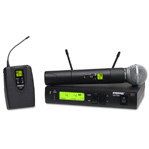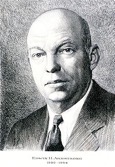Shure Proves Marcus' First law of Spectrum
06 03, 10 09:40

“Free spectrum is always cheaper than efficient wireless technology”
This has been proven in a self congratulatory press release on the “pitchengine.com” website: Shure, Inc. has announced that ”FCC received more than 300 letters, from houses of worship, theaters, education institutions, musicians, producers, sound engineers, AV rental and production companies, hotels, and convention centers during the comment period, which ended on March 1, 2010.”
Actually considering the ubiquity of these recently illegal products, 300 is a rather small number.
The release goes on to say
“Wireless microphone users are sending a strong and clear message that they and their audiences expect and deserve interference-free audio,” said Sandy LaMantia, President and CEO of Shure Incorporated. “Wireless microphones are an essential feature of professional sound production in many contexts where audio quality is a priority. These users need to be eligible for licenses that will afford them protection from interference from new devices using the same spectrum.”
Your blogger agrees. As has been said repeatedly here “"wireless mics are a legitimate use of spectrum (that) deserves more from FCC than benign neglect that allows most users only criminal spectrum squatting”.
But the key policy question is not whether there should be a legal path or wireless mic users, but rather is continued unlimited access to UHF “white space” spectrum an anachronism in the age of current spectrum policy and current wireless technology.
Any one who has observed the evolution of spectrum policy in the past 2 decades realizes that most private sector use of spectrum is subject to economic forces to assure spectrum gets to its highest and best use. There are exceptions for public safety and personal radio services, but not for the huge amount of “beach front” spectrum the wireless mic community seeks continued unfettered access to.
TV spectrum used to go to channel 84, then to channel 69, now it ends at channel 51. It is likely that the pending FCC Broadband Report will try to pack it down smaller. The number of TV stations hasn’t decreased so there is less white space, especially in urban markets. With analog TV, generally only 1 out of 6 channels was used in a given area due to limitation of TV sets - at least when the rules were set in 1953. (The TV broadcasters fought hard in the 1970s against having this reexamined in view of improved technology.)
The basic problem of long term use of UHF for wireless mics is benefit vs. opportunity cost. By the nature of their use, wireless mics using a negligible part of the space-time spectrum resource nationwide, yet they deny that resource to other users who could use it more intensively. While wireless mic spectrum use is intense in the Broadway area for a few hours a day, that is really a small fraction of the land area of the FCC’s jurisdiction.

Why don’t marketplace forces apply to wireless mics? In the UK, FCC’s counterpart, Ofcom has delegated wireless mic issues to a mandatory coordinator named JFMG which charges users for spectrum access and can use its income to procure spectrum. Why doesn’t FCC consider such a band manager for wireless mic use? Of course, the users prefer FREE SPECTRUM!
If wireless mics were used to another band with a more compatible sharing partner, they would not incur any opportunity cost. For example, wireless mics are short range links usually less than 100m and aeronautical telemetry ground stations are not located on Broadway, why can’t they share?

So why isn’t the CTIA crowd interested in providing a new service and a new income stream? They are all looking for “killer apps” like iPhone and don’t want to spend their limited R&D budget on niche markets with potential for only a few million here and there. Wake up CTIA: you covet the same UHF spectrum here yourself and the squandering of this resource on the present technology wireless mics is really a barrier to your own spectrum access. Addressing this market through minor modifications of present cellular products will both give you new income and help break the spectrum log jam!
In reality, wideband FM use of UHF spectrum is the only options for wireless mics for the next 2-4 years. It may be reasonable to let small wireless mic users with few units e.g. small churches and conference rooms, and noncritical use stay in the UHF band on a long term basis. But FCC could take a leadership role here in starting a transition to another technology and band for the large and professional wireless mic users who dominate the spectrum requirement. Broadcasters and Hollywood also may like the long standing deal for free spectrum use for their high income businesses, but that is also an anachronism in today’s policy environment.
blog comments powered by Disqus




![Validate my RSS feed [Valid RSS]](valid-rss-rogers.png)

